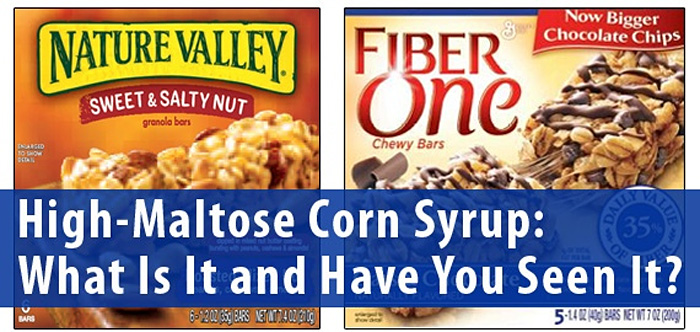
Written By: Sofia Layarda, MPH
Title: Master of Public Health
Alumni: University of California, Berkeley
Last Updated on:

While browsing the shelves at the grocery store, we came across high-maltose corn syrup as an ingredient on a box of granola bars. What is high-maltose corn syrup, and what is its purpose?

Table of Contents
There is less information on high-maltose corn syrup than on high-fructose corn syrup (HFCS). Indeed, we couldn’t find much on PubMed regarding how this specific sweetener is metabolized by the body. Like its more high-profile and often-reviled relative, HFCS, high-maltose corn syrup is made by adding enzymes to cornstarch. Depending on what enzyme is used, syrups of varying maltose concentration can be made. The percentage of maltose starts around 30 to 35% but can go as high as 70%.
We looked at information from Cargill Foods, which produces, among many other things, various types of liquid sweeteners. We found that high-maltose corn syrup is slightly higher in calories per serving than HFCS (324 kcal vs. 284 kcal per 100 g).
There are several reasons why high-maltose corn syrup is used in food processing. First, maltose tastes less sweet than fructose. This could be useful to the manufacturer because it can then be used in sweet food items that may be perceived as “healthy,” such as granola or energy bars, without the product tasting overly sweet. At the same time, maltose is not as hygroscopic (moisture-loving) as glucose, which means the end product made with it will not get sticky as quickly – a useful property when the product is meant to be crispy rather than chewy/moist. High-maltose corn syrup may also be found in combination with HFCS in ice cream, and both sweeteners play a role in the freezing point, mouthfeel, sweetness, and viscosity of the product.
There is not enough information to say whether high-maltose corn syrup is better or worse than HFCS. So, avoid it as much as possible for now. Read ingredient labels on store-bought ice cream and boxed processed foods such as “energy” bars, granola bars, or cookies.
Basically, both high-fructose corn syrup and high-maltose corn syrup are added sugars and are mostly found in processed foods. If you want to avoid them, avoid eating out of a box and make your own homemade version whenever possible.
Alumni: University of California, Berkeley – Sofia believes in bringing back fun and pleasure into everyday eating. She loves cooking, and is constantly experimenting with ingredients, creating recipes and trying them out on family and friends. Her latest interest lies in finding realistic and practical ways of environmentally-friendly food/eating habits.
grocery aisle, healthy snacks, hfcs, high fructose corn syrup